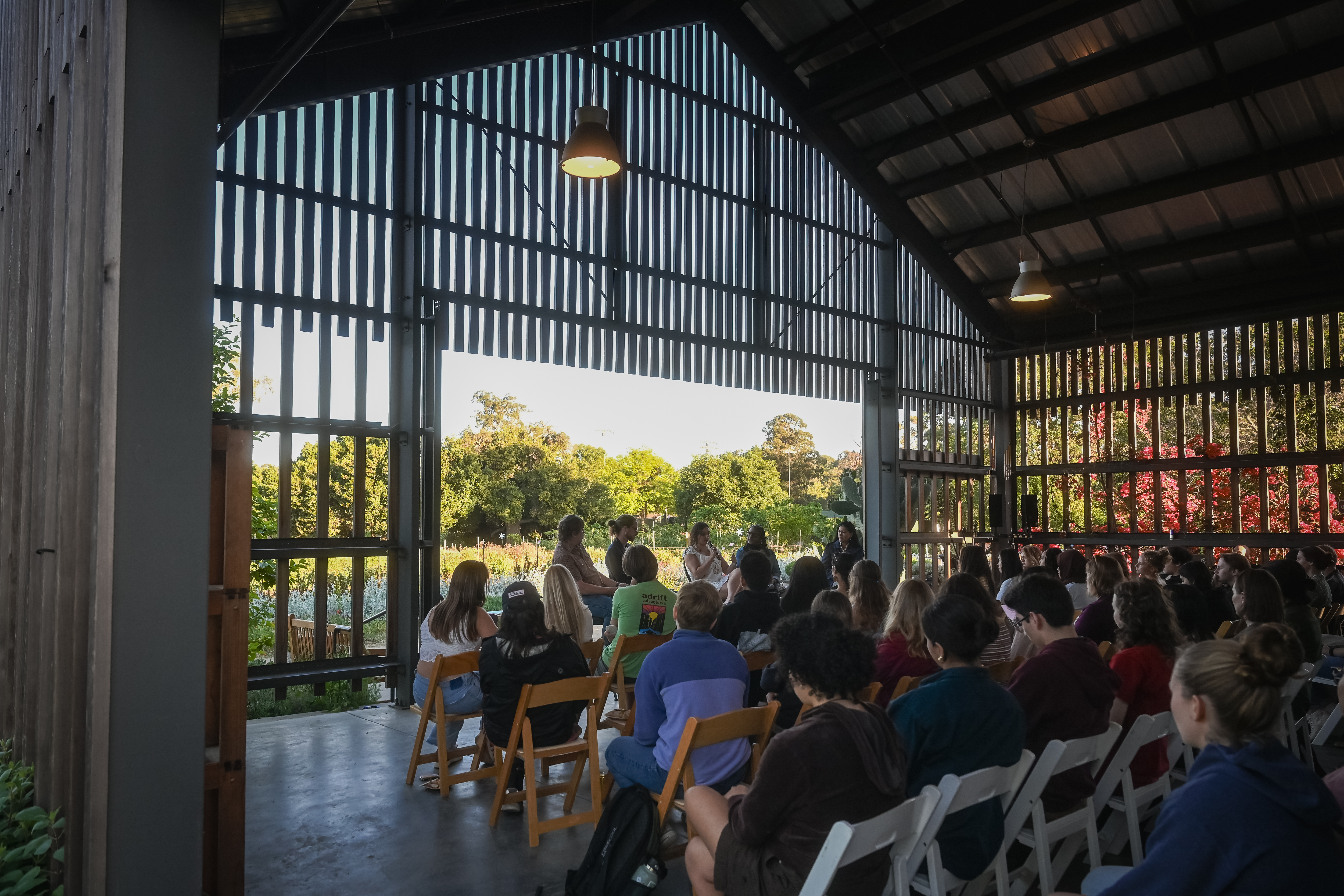Calls to community and healing were the core of this year’s Stanford Rural Panel, a point that Elsie DuBray M.S. ’26 and her fellow panelists emphasized for a healthy and sustainable rural future.
Embraced by the greenery of the O’Donohue Family Stanford Educational Farm last Thursday, the panel was met by an audience of almost 100 students and alumni from varied geographical backgrounds. Hosted by the Stanford Rural Engagement Network, the panel featured “agri-cultural” anthropologist Dr. Gail P. Myers, outfitter and flyfishing guide Hilary Hutcheson, rural political organizer Canyon Woodward and Lakxóta food sovereignty advocate DuBray.
With this year’s talk titled “Land and Community: Cultivating a Sustainable Rural Future,” the panelists reflected on the range of the rural landscape. Exploring topics like eco-grief, rural politics, sustainable indigenous land practices and the crucial role of Black farmers in rural spaces, the talk aimed to bridge the gap between Stanford and the rural world.
While 20% of the U.S. is rural, at Stanford, the rural population makes up only 3-5%of its student body, according to event organizers. This discrepancy pushed moderator Isaac Nehring ’26, a Montana native, to begin the Stanford Rural Panel last year.
“[This panel] brings to light what real students experience and also the ways that policies we pursue, things we build, conversations we have… all affect rural communities, even if we’re not from them ourselves,” Nehring said.
Hutcheson, who owns and operates her own fishing shop in Glacier National Park in Montana, has observed these effects firsthand. Climate change directly impacts locals’ livelihoods, with the park’s glacial rivers melting and native fish species becoming endangered.
Caring for over 300 employees, Hutcheson provides them with eight free counseling sessions. Many of their concerns are rooted in ecological grief or “eco-grief,” a sense of loss that arises from environmental destruction. While she acknowledged that climate change is ravaging the park, she highlighted that it’s also devastating the communities that depend on it.
“They’re supposed to be helping all these visitors coming into Glacier National Park have an amazing time,” Hutcheson said. “But actually, it can be super stressful when suddenly your office space is on fire and then it’s flooded… there’s fish and then there’s no fish, and then it’s 100 degrees and then it’s 29 degrees — all in the same summer.”
This story of ecological grief is mirrored in DuBray’s home of the Cheyenne River Reservation in South Dakota. Growing up on her family’s buffalo ranch, she said that she found the buffalo as a “source of hope,” understanding their restoration as a “reclamation” of her community’s identity and health.
But when DuBray lost nearly 30% of her herd to a cattle disease, she realized that the buffalo were under the biggest threat since their slaughter by the US federal government in the 1800s: climate change. She said that the disease likely came from the drought conditions her home has faced for the last 10-plus years.
“I, for the first time, had to really conceptualize what my existence looks like, what my relationship to the land looks like, when the existence of the buffalo is under threat,” DuBray said.
This loss is not standalone, where DuBray’s reservation is dealing with a mental health crisis that has taken the lives of so many, including her brother. Native American communities have the highest suicide rate of any community in the U.S., with the risks especially high in youth and men.
“When I’m thinking about climate change… I’m not interested in tiptoeing around these conversations anymore,” DuBray said. “Our buffalo are dying. My brother died, our youth are dying. These are very real issues that people in rural communities are facing first.”
Myers, whose research focuses on African-American farmers, has seen the need for expensive adaptation in farmers’ local agriculture due to climate change. The environment has created what she calls a “topsy turvy agro-ecosystem.”
Still, Myers said that the land has historically been the place of healing for African American farmers through rituals and ties, a lesson that can be shared.
“The place to get the healing is the same place in which we get the pain,” Myers said. “It sounds possibly like a contradiction, but the land can hold our hurt, and it can heal us.”
However, Myers highlighted that the voices that matter the most are often drowned out, where rural communities are discovering sustainable innovation but are not being heard.
“Farmers are at the table — there’s innovation,” Myers said, describing the surveys, discussions and conversations farmers have with local governance. “But when it sort of comes down to the final decision, those people in power disregard what rural farmers have to say.”
To power a positive change, Woodward urged young people to organize from within, running for local offices and challenging the cycle of power.
“The enormity of a crisis can feel so paralyzing and create a knot in a stomach that never goes away,” Woodward said. “I think finding ways to plug in and take action in a meaningful way is the best antidote.”
